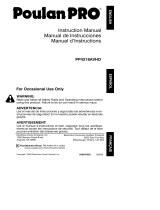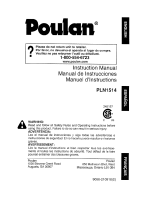
• This saw is equipped with a chain brake.
The brake is designed to stop the chain if
kickback occurs.
• The JnertJa-aetJvated chain brake is
activated if the front hand guard is pushed
forward, either manually (by hand) or
automatically (by sudden movement).
• if the brake is already activated, it is
disengaged by pulling the ftont hand guard
back toward the front handle as far as
possible.
• When cutting with the saw, the chain brake
must be disengaged.
Braking function control
CAUTION: The chain brake must be
checked several times daily. The engine
must be runnfag when performing this proce-
dure. This is the only instance when the saw
should be placed on the ground with the en-
gine running.
Place the saw on firm ground. Grip the rear
handle with your right hand and the front han-
die with your left hand. App}y ful} throttfa by
fulIy depressfag the throttle trigger Activate
the chain brake by turning your Ieft wdst
against the hand guard without releasing
your grip around the front handle. The chain
should stop immediately.
Inertia activating function control
_LWARNING: When performing the
folfawing procedure, the engine must be
turned off.
Grip the rear handIe with your rigM hand and
the front handle with your left hand. Hold the
chain saw approximately 14" (35 cm) above a
stump or other wooden surface Release your
grip on the front handle and use the weight of
the saw to let the tip of the guide bar fal} forward
and contact the stump. When the tip of the bar
hits the stump, the brake should activate.
OPERATING TIPS
• Check chain tension beforefirst use, after
1 minute of operation, and each time be-
fore you start the chain saw. See CHAIN
TENSION in the ASSEMBLY section
• Cut wood only. Do not cut metal, plastics,
masonry, non-wood building materials, etc.
• Stop the saw if the chain strikes a foreign
object, inspect the saw and repair or re-
place parts as necessary. If the chain
jumps off the guide bar, inspect the chain
for damaged drive links before reinstalling.
Burrs on drive links, which prevent them
from entering the groove of the guide bar.
can be removed with a flat file.
• Keep the chain out of dirt and sand Even a
small amount of dirt will dull a chain, increase
the possibility of kickback, and require chain
sharpening or replacement
• Practice cutting a few small logs using the
following techniques to get the "feeF of us-
ing your saw before you begin a major
sawing operetJon.
• Squeeze the throttle trigger and allow the
enginetoreachfullspeed beforecutting
• Begin cutting with the saw frame
against the Iog.
• Keep the engfae at fulI speed the entke
time you are cutting.
• Alfawthechafatccutforyou. Exerfonly
light downward pressure if you force
the cut, damage to the bar, chain, or en-
gine can result.
• Release the throttIe trigger as soon as
the cut is completed, alfawing the en-
gfae to idle. If you run the saw at full
thrott fa without a cutting load, unneces-
sary wear can occur to the chair], bar,
and engine. It is recommended that
the engine not be operated for lon-
ger than 30 seconds at full throttle.
• To avoid losing conttol when cut is com-
plete, do not put pressure on saw at end
of cut.
• Stop the engine before setting the saw
down after cutting
TREE FELLING TECHNIQUES
_tLWARNING: Check for broken or
dead branches which can fall while cutting
causing serious injury. Do not cut near build-
ings or electhcal wires if you do not know the
direction of tree fall, nor cut at night since you
wilI not be ale to see well nor during bad
weather such as rain, snow, or strong winds,
etc. If the tree makes contact w_th any ul31ity
line, the utility company should be notified im-
mediately
• Carefully plan your sawing operation fa ad-
vance.
• Cfaar the work area. You need a clear area
all around the tree so you can have secure
footing.
• The chain saw operator should keep on
the uphil} side of the terrain as the tree is
Iikely to roll or slide downhiII after it is felled
• Study the natural condrtions that can cause
the tree to fall in a par_cu}ar direction.
Natural conditions that can cause a tree to
fall in a particuIar direction include:
• The wind direction and speed.
• The lean of the tree. The lean of a tree
might not be apparent due to uneven or
sfapfag terrafa. Use a plumb or level to de-
termfae the direction of tree lean.
• Weight and branches on one side.
• Surrounding trees and obstacles
Look for decay and rot. If the trunk is rotted,
it can snap and fall toward the operator
Check for broken or dead branches which
can fall on you while cutting.
Make sure there is enough room for the tree to
fall Maintain a distance of 2 1/2 tree lengths
from the nearest person or other objects En-
gine noise can drown out a warning call.
Remove dirt, stones, loose bark, nails, sta-
ples, and wire from the tree where cuts are to
be made. Pfan a clear retreat path to the rear
and diagonal to the line of fall.
11






















